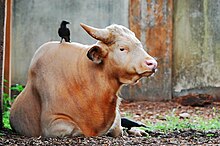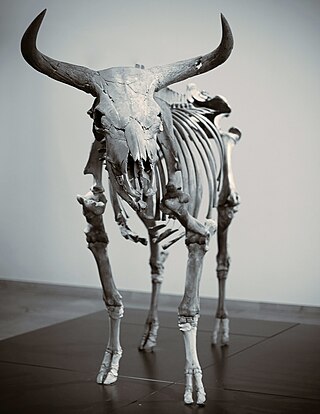
The aurochs is an extinct cattle species, considered to be the wild ancestor of modern domestic cattle. With a shoulder height of up to 180 cm (71 in) in bulls and 155 cm (61 in) in cows, it was one of the largest herbivores in the Holocene; it had massive elongated and broad horns that reached 80 cm (31 in) in length.

The zebu, sometimes known in the plural as indicine cattle, Camel cow or humped cattle, is a species or subspecies of domestic cattle originating in South Asia. Zebu, like many Sanga cattle breeds, differs from taurine cattle by a fatty hump on their shoulders, a large dewlap, and sometimes drooping ears. They are well adapted to withstanding high temperatures and are farmed throughout the tropics.

Bovines comprise a diverse group of 10 genera of medium to large-sized ungulates, including cattle, bison, African buffalo, water buffalos, and the four-horned and spiral-horned antelopes. The evolutionary relationship between the members of the group is still debated, and their classification into loose tribes rather than formal subgroups reflects this uncertainty. General characteristics include cloven hooves and usually at least one of the sexes of a species having true horns. The largest extant bovine is the gaur.

Bos is the genus of wild and domestic cattle. Bos is often divided into four subgenera: Bos, Bibos, Novibos, and Poephagus, but including these last three divisions within the genus Bos without including Bison in the genus is believed to be paraphyletic by many workers on the classification of the genus since the 1980s. The genus as traditionally defined has five extant species but this rises to eight when the domesticated varieties are counted as separate species, and 10 when the closely related genus Bison is also included. Most but not all modern breeds of domesticated cattle are believed to have originated from the extinct aurochs. Many ancient breeds are thought to have originated from other species. Zebus and taurine cattle are thought to descend from ancient Indian and Middle Eastern aurochs, respectively.
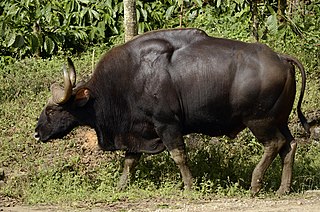
The gaur, also known as the Indian bison, is a bovine native to South Asia and Southeast Asia, and has been listed as Vulnerable on the IUCN Red List since 1986. The global population was estimated at a maximum of 21,000 mature individuals in 2016, with the majority of those existing in India.

The yak, also known as the Tartary ox, grunting ox, or hairy cattle, is a species of long-haired domesticated cattle found throughout the Himalayan region of South Asia, the Tibetan Plateau, Gilgit-Baltistan (Kashmir), Tajikistan and as far north as Mongolia and Siberia. It is descended from the wild yak.

The Bovidae comprise the biological family of cloven-hoofed, ruminant mammals that includes cattle, yaks, bison, buffalo, antelopes, sheep and goats. A member of this family is called a bovid. With 143 extant species and 300 known extinct species, the family Bovidae consists of 11 major subfamilies and thirteen major tribes. The family evolved 20 million years ago, in the early Miocene.

The kouprey, also known as the forest ox and grey ox, is a possibly extinct species of forest-dwelling wild bovine native to Southeast Asia. It was first scientifically described in 1937. The name kouprey is derived from the Khmer language and means "forest ox".

The banteng, also known as tembadau, is a species of cattle found in Southeast Asia. The head-and-body length is between 1.9 and 3.68 m. Wild banteng are typically larger and heavier than their domesticated counterparts, but are otherwise similar in appearance. The banteng shows extensive sexual dimorphism; adult bulls are generally dark brown to black, larger and more sturdily built than adult cows, which are thinner and usually pale brown or chestnut red. There is a big white patch on the rump. Horns are present on both sexes, and are typically 60 to 95 cm long. Three subspecies are generally recognised.
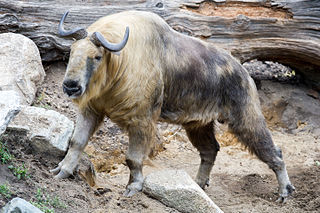
The takin, also called cattle chamois or gnu goat, is a large species of ungulate of the subfamily Caprinae found in the eastern Himalayas. It includes four subspecies: the Mishmi takin, the golden takin, the Tibetan takin, and the Bhutan takin.

A bovid hybrid is the hybrid offspring of members of two different species of the bovid family. There are 143 extant species of bovid, and the widespread domestication of several species has led to an interest in hybridisation for the purpose of encouraging traits useful to humans, and to preserve declining populations. Bovid hybrids may occur naturally through undirected interbreeding, traditional pastoral practices, or may be the result of modern interventions, sometimes bringing together species from different parts of the world.

A semi-feral animal lives predominantly in a feral state but has some contact and experience with humans. This may be because it was born in a domesticated state and then reverted to life in wild conditions, or it may be an animal that grew up in essentially wild conditions but has developed a comfort level with humans through feeding, receiving medical care, or similar contacts.

The Brahmaputra Valley semi-evergreen forests is a tropical moist broadleaf forest ecoregion of Northeastern India, southern Bhutan and adjacent Bangladesh.
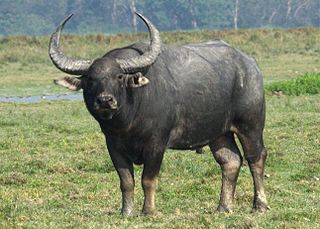
The wild water buffalo, also called Asian buffalo, Asiatic buffalo and wild buffalo, is a large bovine native to the Indian subcontinent and Southeast Asia. It has been listed as Endangered in the IUCN Red List since 1986, as the remaining population totals less than 4,000. A population decline of at least 50% over the last three generations is projected to continue. The global population has been estimated at 3,400 individuals, of which 3,100 (91%) live in India, mostly in Assam. The wild water buffalo is the most likely ancestor of the domestic water buffalo.

The tribe Bovini, or wild cattle, are medium to massive bovines that are native to Eurasia, North America, and Africa. These include the enigmatic, antelope-like saola, the African and Asiatic buffalos, and a clade that consists of bison and the wild cattle of the genus Bos. Not only are they the largest members of the subfamily Bovinae, they are the largest species of their family Bovidae. The largest species is the gaur, weighing up to 1,500 kg (3,300 lb).

The Indian aurochs is an extinct subspecies of aurochs that inhabited West Asia and the Indian subcontinent from the Late Pleistocene to its extinction during the South Asian Stone Age. With no remains younger than 3,800 YBP ever found, the Indian aurochs was the first of the three aurochs subspecies to become extinct, while the North African and Eurasian subspecies survived until the Roman and Modern times, respectively.
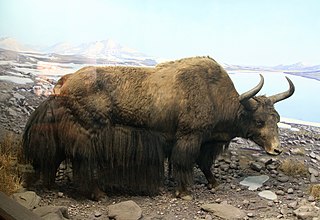
The wild yak is a large, wild bovine native to the Himalayas. It is the ancestor of the domestic yak.

Bovidae in Chinese mythology include various myths and legends about a group of biologically distinct animals which form important motifs within Chinese mythology. There are many myths about the animals modernly classified as Bovidae, referring to oxen, sheep, goats, and mythological types such as "unicorns". Chinese mythology refers to those myths found in the historical geographic area of China, a geographic area which has evolved or changed somewhat through history. Thus this includes myths in Chinese and other languages, as transmitted by Han Chinese as well as other ethnic groups. There are various motifs of animals of the Bovidae biological family in Chinese mythology. These have often served as allusions in poetry and other literature. Some species are also used in the traditional Chinese calendar and time-keeping system.
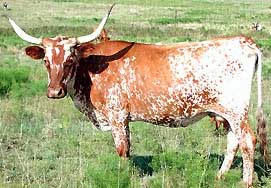
Bovina is a subtribe of the Bovini tribe that generally includes the two living genera, Bison and Bos. However, this dichotomy has been challenged recently by molecular work that suggests that Bison should be regarded as a subgenus of Bos. Wild bovinans can be found naturally in North America and Eurasia.


